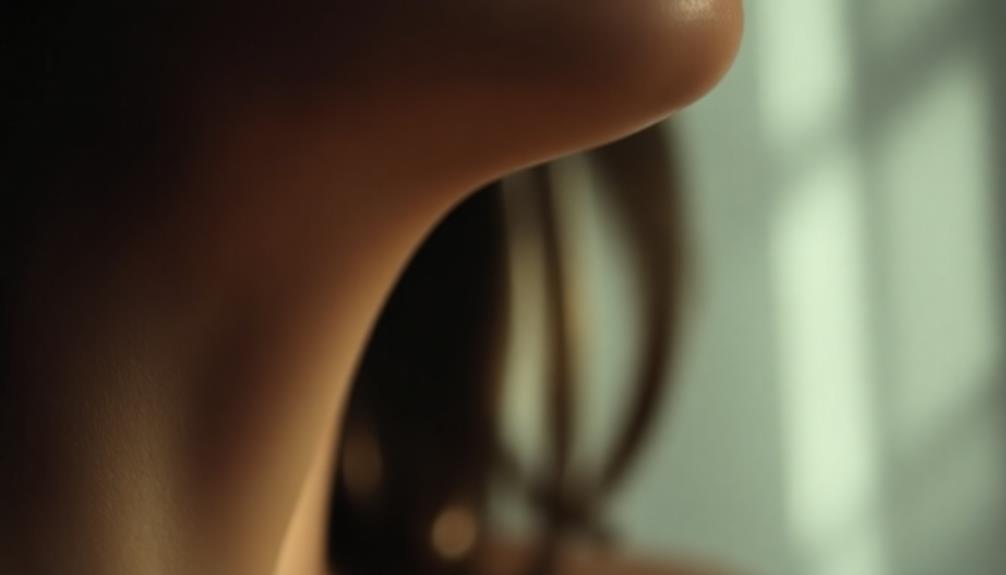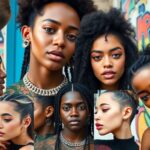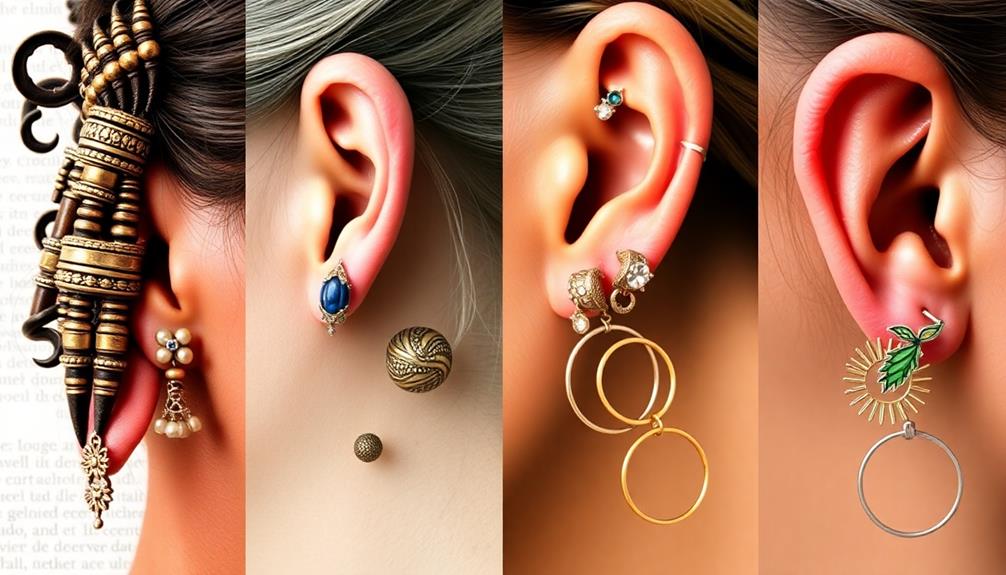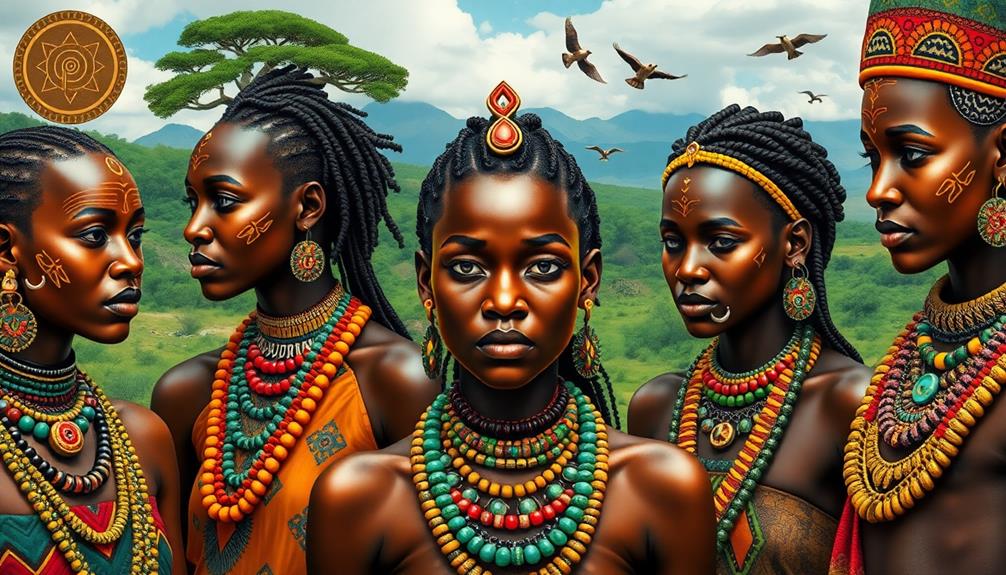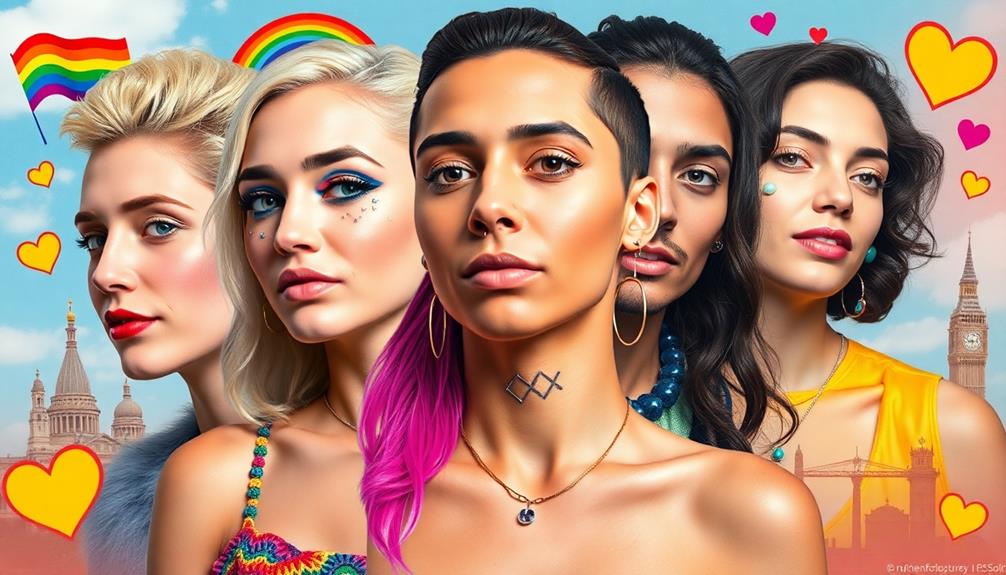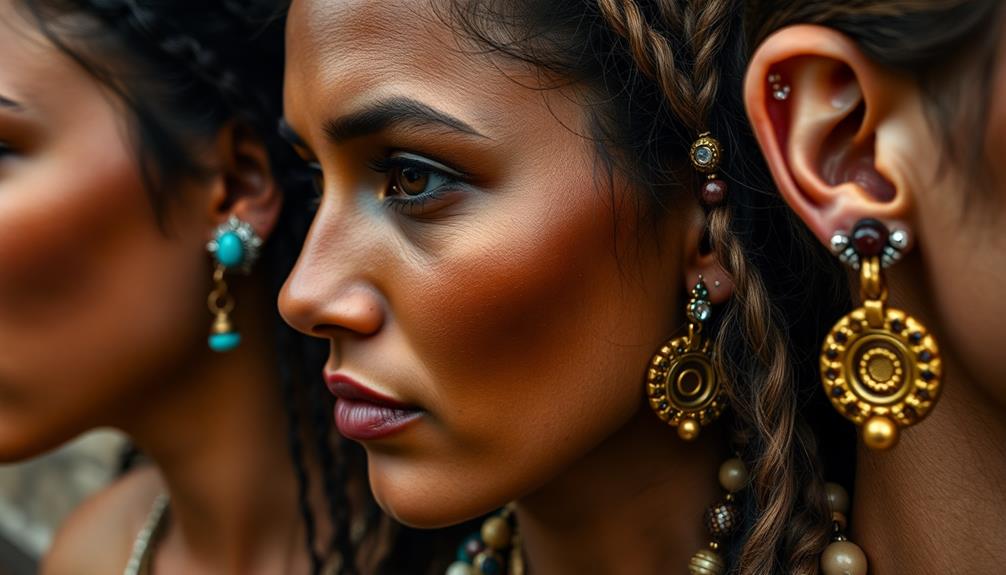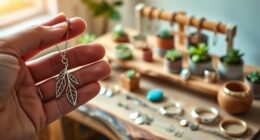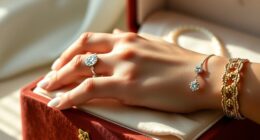Celebrities greatly shape piercing trends, making them a standout aspect of modern pop culture. When stars like Rihanna and Miley Cyrus flaunt new piercings, it instantly creates buzz and drives fans to mimic their styles. Social media amplifies this effect, with platforms like Instagram showcasing unique body art, generating visibility and inspiring others to embrace piercings. As acceptance grows—around 40% of U.S. adults have at least one piercing—so does the exploration of creative styles. If you're curious about how these shifts continue to evolve, you'll find more insights ahead.
Key Takeaways
- Celebrities like Miley Cyrus and Rihanna popularize specific piercing styles, significantly influencing public adoption and trends.
- Social media platforms, especially Instagram and TikTok, amplify celebrity piercings, increasing visibility and demand for similar styles.
- Tommy Lee's nipple piercings and punk icons symbolize rebellion, inspiring individuals to explore more unconventional piercing options.
- Approximately 40% of U.S. adults now have at least one piercing, reflecting the normalization of body art in fashion influenced by celebrities.
- Contemporary styles, such as septum and dermal piercings, gain traction due to celebrity endorsements and social media trends.
Celebrity Impact on Piercing Trends

Celebrities have undeniably shaped piercing trends, with figures like Miley Cyrus and Janet Jackson leading the charge in popularizing various styles. Their influence extends beyond just personal choices; it reflects a broader acceptance of body piercings as a fashion statement.
Social media platforms like Instagram and TikTok amplify this impact, giving you a front-row seat to celebrity piercings and inspiring you to adopt similar styles.
For instance, when Tommy Lee showcased his nipple piercings, it sparked a surge in popularity, making it clear how personal choices by public figures can drive mainstream trends.
You might notice that iconic figures from the punk and goth subcultures, like Sid Vicious and Joan Jett, transformed multiple piercings into symbols of rebellion and self-expression. This shift in cultural perception has encouraged many to embrace body art without hesitation.
Research indicates that around 40% of adults in the U.S. have at least one body piercing. This figure underscores the significant role celebrities play in normalizing these fashion trends, proving that their influence can extend far beyond the red carpet.
Historical Context of Body Piercings
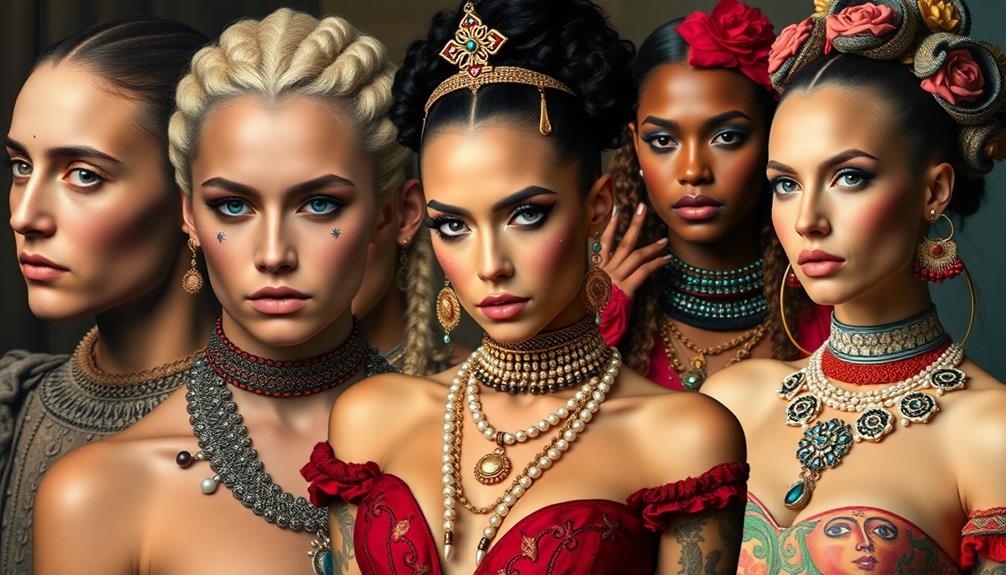
Body piercings have a fascinating history that dates back thousands of years, with ancient Egyptians using them to showcase wealth and status.
As you explore the evolution of piercing culture, you'll see how these practices transformed from symbols of bravery among Roman soldiers to a form of self-expression in modern times.
Understanding this historical context helps you appreciate how far piercings have come in society.
Ancient Practices and Significance
Throughout history, people have adorned themselves with piercings for various reasons, from denoting social status to marking rites of passage. The cultural significance of body modification is evident across many ancient civilizations.
- In Egypt, gold earrings and nose rings signified wealth and status among royals.
- Roman soldiers donned nipple rings to represent bravery and military rank.
- In India, nose piercings have long been part of women's beauty and cultural identity.
- The Maasai tribe utilizes ear stretching as a rite of passage, signifying maturity.
- For the Kayapo, lip plates connect individuals to their ancestors, showcasing deep cultural roots.
These practices reflect how piercings serve as powerful symbols of identity and community. Each culture imbues body modifications with unique meanings, illustrating how deeply intertwined these adornments are with societal values.
From ancient royalty to tribal traditions, the significance of piercings extends beyond mere decoration, highlighting a rich history that continues to influence contemporary practices. Understanding these ancient customs helps you appreciate the diverse tapestry of meanings behind body piercings today.
Evolution of Piercing Culture
Piercing culture has undergone a remarkable transformation over the centuries, evolving from ancient rituals to a widespread form of self-expression. In ancient civilizations like Egypt and Rome, body piercings became symbols of wealth, bravery, and social status.
Fast forward to 1978, when the first professional piercing studio opened in West Hollywood, marking a significant shift from underground practices to mainstream acceptance of body adornment.
The 1990s saw a surge in popularity for piercings, especially among youth, as celebrities like Lindsay Lohan and the Spice Girls showcased various styles. Their influence turned piercings into a rite of passage, encouraging many to embrace this form of self-expression.
By the 2010s, piercings evolved further, with contemporary styles like dermals and bridge piercings emerging, inspired by cultural icons such as Scarlett Johansson and Hayley Williams.
Today, around 40% of adults in the U.S. have at least one body piercing, reflecting the normalization and acceptance of body modifications. What once carried deep cultural meanings has now become a personal choice, showcasing individuality and creativity in today's diverse society.
Cultural Significance Across Societies
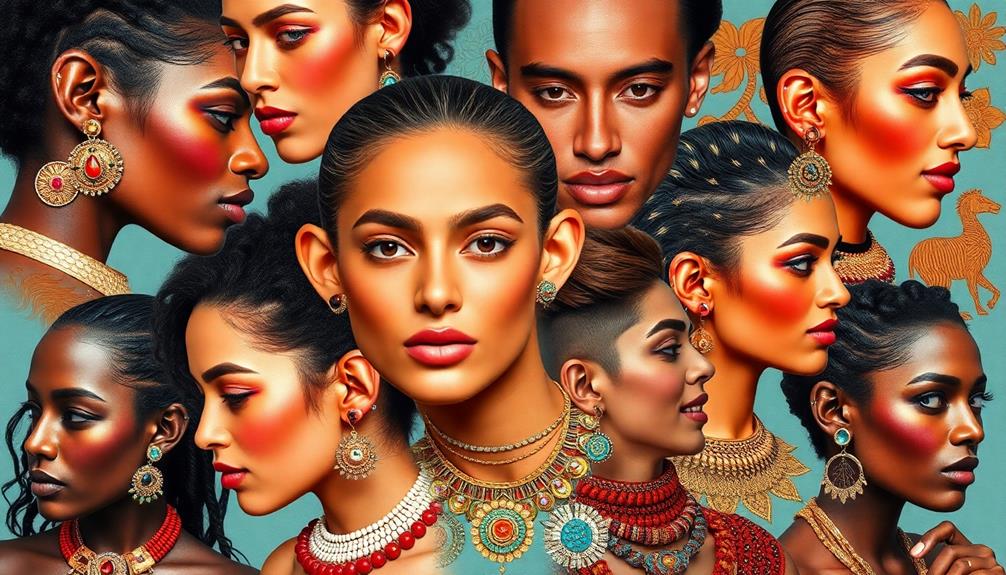
Historically, body modifications like piercings have played an essential role in various cultures, often symbolizing more than mere aesthetics. Each culture imbues body piercings with unique meanings, reflecting values and traditions that span generations.
Consider these key cultural significances of piercings across societies:
- In ancient Egypt, gold earrings and nose rings indicated wealth and status among royals.
- In India, nose piercings are tied to beauty and marital status, showcasing deep-rooted traditions.
- Maasai and Kayapo tribes use body piercings as rites of passage, marking maturity and community belonging.
- Some cultures view piercings as spiritual protection, believing they ward off negative energies.
- Contemporary subcultures often embrace piercings as forms of rebellion or personal expression.
Through these examples, you can see how body piercings serve as markers of identity and community connection.
As societal norms evolve, the cultural significance of piercings shifts from symbols of status to expressions of individuality.
Self-Expression Through Body Art

As the cultural significance of piercings evolves, they increasingly become a canvas for personal expression. Celebrities like Miley Cyrus and Rihanna lead the way, showcasing unique styles that inspire you to explore body jewelry options that reflect your individuality. With the rise of multiple ear piercings, especially among millennials, it's clear that body adornments serve as a powerful means of self-identification.
Here's a look at some popular piercing trends:
| Trend | Description |
|---|---|
| Multiple Ear Piercings | Layering different styles for a unique look |
| Statement Nose Rings | Bold choices that stand out |
| Lip Piercings | Subtle yet impactful body art |
| Septum Piercings | A rebellious statement |
| Facial Piercings | Expressing creativity and personal style |
Social media platforms like Instagram and TikTok play significant roles in shaping these trends, allowing you to connect with communities that celebrate self-expression through piercings. As 40% of U.S. adults now have at least one body piercing, it's clear that these modifications are increasingly accepted as reflections of personal identity, challenging traditional beauty standards and asserting independence.
Evolution of Piercing Styles
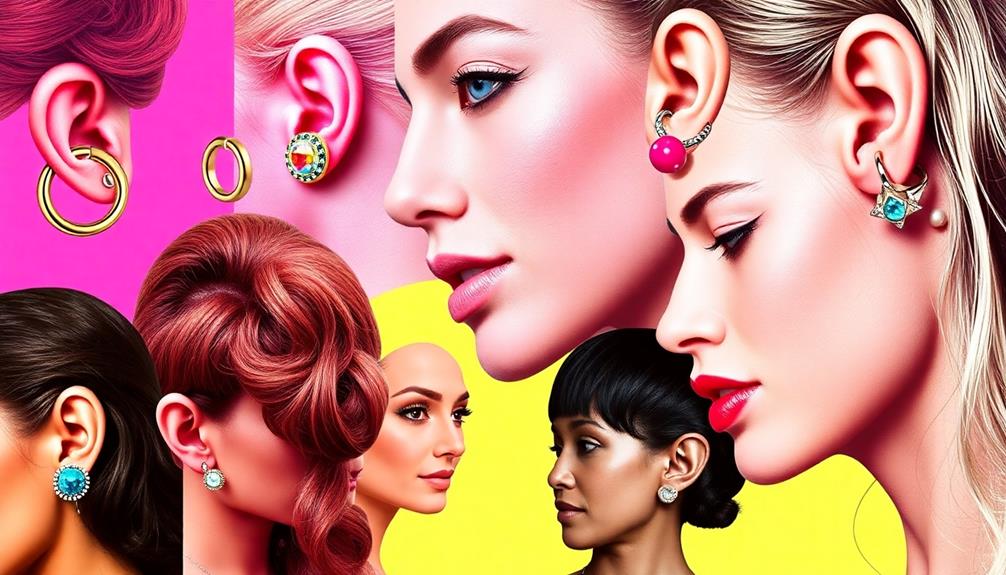
When you look at the evolution of piercing styles, you can see how historical influences and cultural shifts have shaped what's popular today.
Celebrities play a significant role in driving these trends, making certain piercings a must-have for many.
As you explore these changes, you'll notice how social media amplifies these styles, bringing unique options to the forefront.
Historical Influences on Styles
Evolving from niche underground movements, body piercings have transformed into a prominent aspect of mainstream fashion and self-expression. In the 1970s, piercings began as a form of rebellion, primarily within punk and queer cultures. This marked a considerable shift in societal perceptions surrounding body modifications.
By the 1990s, celebrities like Lindsay Lohan and the Spice Girls made piercings more acceptable, popularizing lobe and navel styles. As people sought new ways to express themselves, various types of piercings, such as clitoral hood piercings, emerged, enhancing not only aesthetics but also sexual pleasure and self-esteem enhances sexual pleasure.
As we moved into the 2010s, iconic figures such as Scarlett Johansson and Hayley Williams brought attention to septum piercings, sparking renewed interest. Social media platforms amplified this trend, allowing influencers and celebrities to showcase their unique piercing styles, which encouraged fans to explore new looks.
Consider these key historical influences:
- 1970s: Underground punk and queer cultures embrace piercings.
- 1990s: Mainstream acceptance grows with celebrity endorsements.
- 2010s: Resurgence of septum piercings led by iconic figures.
- Social media: Amplifies visibility of diverse piercing styles.
- Current trends: 40% of U.S. adults now have at least one body modification.
This evolution illustrates how celebrities greatly impact piercing trends today.
Contemporary Celebrity Impact
Today, celebrities play an essential role in shaping the evolution of piercing styles, with their influence often dictating what becomes trendy. The journey began in 1978 when Jim Ward opened the first piercing studio in West Hollywood, pushing body piercings from the underground to mainstream fashion.
In the 1990s, stars like Lindsay Lohan and the Spice Girls made lobe piercings a rite of passage for teens, while Destiny's Child popularized navel piercings alongside crop top fashion.
As we moved into the 2000s, septum piercings gained momentum thanks to icons like Scarlett Johansson and Hayley Williams, solidifying their place in contemporary fashion.
Nowadays, social media platforms like TikTok and Instagram amplify this impact, allowing influencers to showcase unique piercing styles and connect with a wider audience. This visibility has led to a booming piercing industry valued at around $1 billion annually, particularly appealing to millennials and Gen Z, who are more open to multiple piercings.
With celebrities continuously pushing boundaries, the world of piercing constantly evolves, reflecting changing attitudes towards body art and self-expression.
Cultural Shifts in Piercing
Throughout the decades, piercings have transformed considerably, reflecting broader cultural shifts and changing attitudes toward body art.
In the 1970s, you'd find piercings in underground punk and queer cultures, but by the 1990s, they entered the mainstream, thanks to celebrities like Lindsay Lohan and The Spice Girls popularizing lobe piercings as a teenage rite of passage.
As trends evolved, the early 2000s brought navel piercings into the spotlight, influenced by pop icons like Destiny's Child.
Fast forward to the 2010s, and septum piercings became a sensation, largely due to stars like Scarlett Johansson and Hayley Williams. Cartilage piercings also made a comeback, thanks to characters like Jane Lane.
Today, social media plays an essential role in shaping piercing trends, with platforms like TikTok and Instagram showcasing diverse styles and breaking down stigma.
Key cultural shifts include:
- The punk origins of piercings
- Lobe piercings as a teen staple
- Navel piercings and crop tops
- The rise of septum piercings
- Social media's impact on piercing acceptance
With each shift, piercings continue to reflect your evolving identity and societal values.
Changing Perceptions in Society
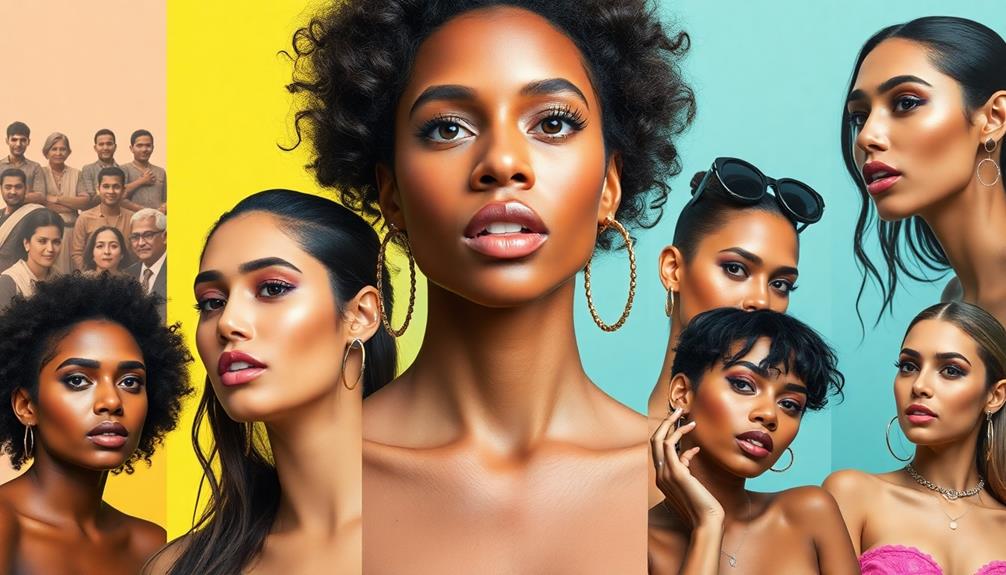
Body piercings have evolved from taboo to trend, reflecting a significant shift in societal attitudes. The stigma once associated with body piercings has diminished considerably, thanks in large part to increased visibility in media.
Nowadays, around 40% of adults in the U.S. sport at least one piercing, showcasing changing perceptions about body modifications as more people embrace them as fashion statements. As individuals focus on their unique identities, they often adopt a mindset that aligns with Abraham's Business Success Principles, emphasizing self-expression and personal growth.
Celebrities like Miley Cyrus and Rihanna have been pivotal in reshaping how society views piercings. By showcasing their own body art in various social contexts, they've helped normalize piercings, making them a staple in contemporary fashion.
Social media platforms like TikTok and Instagram have further accelerated this acceptance, allowing trends to spread quickly among younger generations enthusiastic to express their individuality.
The piercing industry, valued at approximately $1 billion annually, underscores this growing cultural acceptance. As piercings become more integrated into everyday fashion, you'll find that they're no longer seen as rebellious but rather as a form of self-expression.
This evolving landscape highlights how society's changing perceptions are reshaping the narrative surrounding body art, making it an integral part of modern style.
Medical and Ethical Considerations
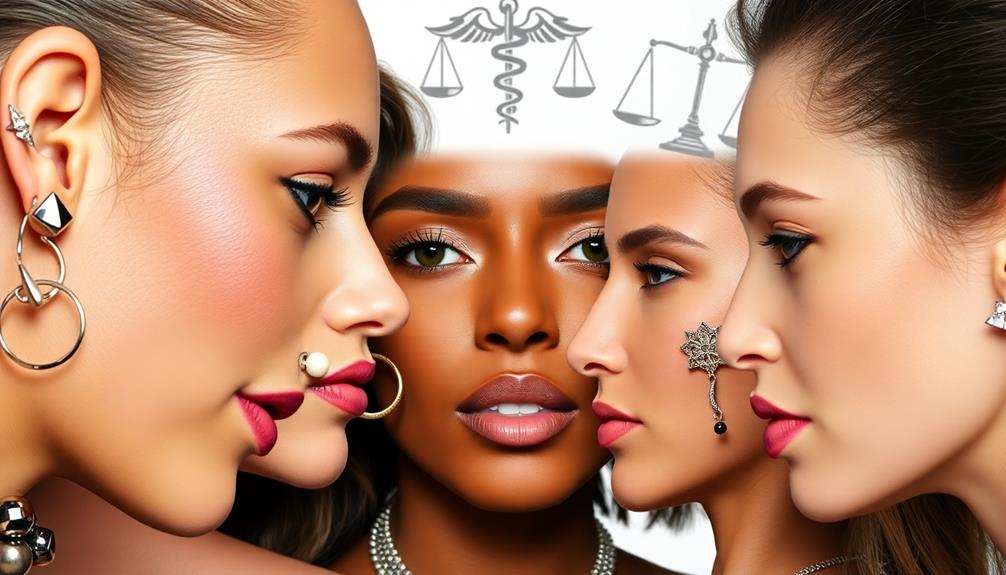
When you consider getting a piercing, it's essential to weigh the health risks, like infections and allergic reactions, against the potential benefits.
Ethical practices in piercing, including respecting cultural significance and informed consent, are just as important as ensuring you're in safe hands.
Health Risks and Safety
In recent years, the popularity of body piercings has surged, bringing with it a need for awareness about health risks and safety. While piercings can be a form of self-expression, they aren't without their dangers.
To guarantee a positive experience, it's crucial to take certain precautions. For instance, just as with dental health, improper techniques can lead to complications such as infections, emphasizing the importance of seeking thorough professional guidance.
Additionally, understanding the hidden dangers of DIY treatments can help individuals make informed choices.
- Always seek consultation with reputable piercing professionals.
- Opt for biocompatible materials like titanium or niobium to reduce allergic reactions.
- Follow proper aftercare instructions to minimize infection risks.
- Be aware of potential complications such as scarring or body rejection.
- Educate yourself on safe piercing techniques and hygiene practices.
Ethical Piercing Practices
While traversing the world of body piercings, understanding ethical practices is vital for both the client and the piercer. First and foremost, you should choose a reputable piercer who follows sterile techniques to minimize the risk of infections and complications. This includes using biocompatible materials like titanium and niobium, which greatly reduce the chances of body rejection and adverse skin reactions.
It's also important to educate yourself about aftercare practices. Proper aftercare prevents allergic reactions, scarring, and promotes healing, ensuring that your piercing experience is positive.
Ethical considerations go beyond the physical; obtaining informed consent is essential. You should be aware of the cultural significance behind specific piercing practices and engage in respectful dialogue with your piercer.
Moreover, the rise of body positivity movements encourages you to embrace your choices without fear of judgment. By understanding these ethical practices, you not only empower yourself but also contribute to a culture of respect and awareness around body modifications.
Cultural Appropriation Concerns
Cultural appropriation concerns in body piercings often arise at the intersection of appreciation and exploitation. When individuals from dominant cultures adopt piercing practices from marginalized communities, they risk disrespecting the significance and history behind these traditions.
This commodification can undermine the cultural heritage of those communities, leading to ethical dilemmas.
To navigate these issues, consider the following:
- Understand the significance: Research the cultural meanings behind specific body piercings.
- Obtain informed consent: Recognize the importance of respecting the traditions of others.
- Avoid stereotypes: Be mindful of how your choices may perpetuate harmful narratives.
- Engage with diverse communities: Foster relationships with those who hold traditional knowledge.
- Balance expression and respect: Find ways to honor cultural practices while embracing your individuality.
Popular Types of Body Piercings

Body piercings have become a prominent form of self-expression, with various styles gaining traction in pop culture. Among the most popular types are ear piercings, which remain the most common, with piercing studios seeing an average of five appointments daily.
Cartilage piercings, like conch and helix styles, have surged by 20%, particularly among younger generations enthusiastic to showcase their individuality.
Navel piercings also made a significant comeback, especially in the early 2000s, inspired by celebrities like Destiny's Child who embraced crop tops, making this piercing a fashion staple.
Eyebrow piercings have carved out a niche for those looking to make a bold statement, often seen on influencers and artists who challenge traditional beauty norms.
Nose rings, too, have gained popularity, thanks in part to celebrities like Scarlett Johansson and Hayley Williams who showcased septum piercings in public.
Finally, microdermal piercings, introduced around 2004, offer an avant-garde style and are often placed in unique areas like temples and outer wrists, reflecting the ever-evolving landscape of body modifications.
Each piercing type contributes to the vibrant tapestry of personal expression in today's culture.
Future Trends in Body Modifications
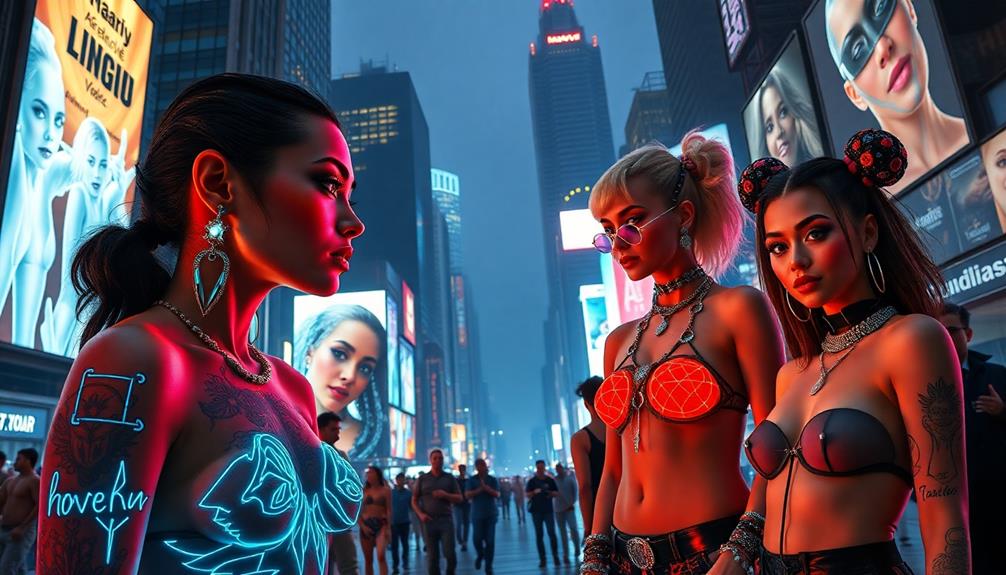
As body piercings continue to evolve in pop culture, future trends in body modifications are set to reflect an even greater emphasis on individuality and self-expression.
Young people, influenced by celebrities, are likely to drive these trends as they seek unique ways to showcase their identities.
Here's what you can expect:
- Unconventional placements: Expect to see more microdermals and piercings in non-traditional areas becoming mainstream.
- Celebrity influence: As public figures flaunt their latest piercing styles, fans will enthusiastically replicate these looks.
- Diverse acceptance: The growing acceptance of body modifications across demographics will lead to an increase in piercing studios and professional services.
- Body positivity movement: The ongoing emphasis on body positivity will encourage more people to embrace piercings as a form of self-expression.
- Fashion integration: Body jewelry will be integrated into everyday fashion, making piercings a staple accessory rather than a niche choice.
With these trends, expect piercings to become an even more prominent aspect of personal style, reflecting each individual's journey and creativity in the years to come.
Social Media's Role in Trends

Social media's influence on piercing trends is undeniable, shaping how people express their individuality through body art. Platforms like Instagram and TikTok play a significant role, allowing users to share their unique piercing styles and experiences, which can lead to viral popularity.
When celebrities flaunt their piercing choices online, it often prompts you and countless others to emulate their looks, driving spikes in demand for specific types of piercings.
The hashtag #piercings on Instagram has amassed millions of posts, fostering a vibrant community that encourages experimentation and celebrates diverse body modifications.
This real-time feedback and engagement lets trends spread rapidly, with new styles gaining visibility through likes, shares, and comments. As you scroll through your feed, it's easy to see how social media emphasizes visual aesthetics, leading to the rise of curated piercing collections.
These collections showcase multiple piercings in cohesive and fashionable ways, inspiring you to explore your own body art.
In this digital age, social media's role in shaping piercing trends is essential, making it an important tool for anyone looking to express themselves through body art.
Frequently Asked Questions
What Are the Most Common Types of Piercings Among Celebrities?
You'll often see celebrities sporting ear piercings, like lobes and helix styles. Nose piercings, especially septum, are also popular. Lip and eyebrow piercings add flair, while some favor more unique options, showcasing personal style.
How Can I Safely Care for New Piercings?
Caring for new piercings is like nurturing a delicate flower. Clean them daily with saline solution, avoid touching or twisting, and steer clear of swimming pools. Your patience will bloom into beautiful, healthy piercings!
Are There Age Restrictions for Getting Piercings?
Yes, there are age restrictions for getting piercings. Most studios require parental consent for those under 18. It's best to check local laws and individual studio policies to guarantee you're following the rules.
What Piercing Trends Are Expected in the Upcoming Year?
Imagine a garden of eclectic blooms; in the upcoming year, you'll see stacked ear piercings, vibrant gemstone studs, and minimalistic nose rings. These trends are all about personal expression and embracing unique styles that reflect you.
How Do I Choose a Reputable Piercing Studio?
To choose a reputable piercing studio, research online reviews, ask friends for recommendations, and visit the studio to assess cleanliness and professionalism. Don't hesitate to ask about their experience and sterilization practices before committing.
Conclusion
As you scroll through social media, you can't help but notice how celebrities' piercings spark your own curiosity. Each stud and hoop tells a story, weaving a tapestry of self-expression and cultural significance. Just like fashion, trends in body art evolve, reflecting our society's changing values. Whether it's a delicate nose ring or a bold septum, you see how these choices connect us, revealing layers of identity that resonate with your own personal journey in the world of body modifications.
Hi, my name is Danielle, and I’m an author for piercings-body.com. I have a passion for writing and love to share my knowledge on all things body piercing-related. I’m also a huge advocate for safe body modification practices and believe everyone should be able to make informed decisions about their bodies. When I’m not writing or blogging, I enjoy spending time with my family and friends, practicing yoga, and exploring new places.


